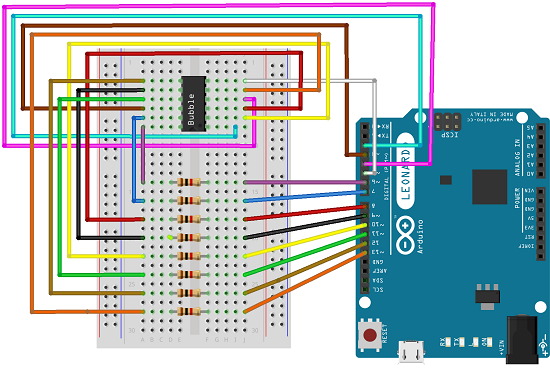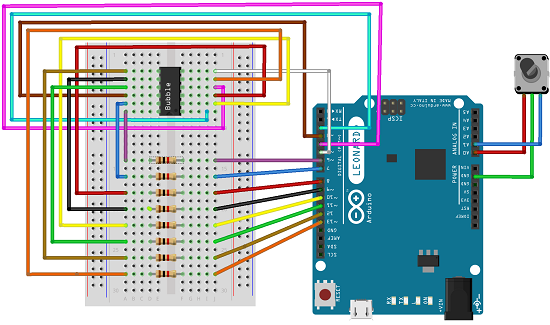Bubble Display
Introduction
In this project you will be able to use a 4 digit, 7 segment bubble display to count numbers.
You Will Need
- 8x 1K Ohm Resistors
- Lots of jumper wires
- The Library for the sketch, here
- A sparkfun Bubble display. You can get one here
The bubble display looks like this

Making the circuit
Here is a sketch that shows you how to make the circuit

Coding
This sketch will count from 1 to 9999
/*
March 6, 2014
Spark Fun Electronics
Nathan Seidle
Updates by Joel Bartlett
This code is originally based Dean Reading's Library deanreading@hotmail.com
http://arduino.cc/playground/Main/SevenSegmentLibrary
He didn't have a license on it so I hope he doesn't mind me
making it public domain:
This code is public domain but you buy me a beer if you use this
and we meet someday (Beerware license).
This sketch provides a simple counter example for the
HP Bubble display from SparkFun.
https://www.sparkfun.com/products/12710
Pinout for HP Bubble Display:
1: Cathode 1
2: Anode E
3: Anode C
4: Cathode 3
5: Anode dp
6: Cathode 4
7: Anode G
8: Anode D
9: Anode F
10: Cathode 2
11: Anode B
12: Anode A
*/
#include "SevSeg.h"
//Create an instance of the object.
SevSeg myDisplay;
//Create global variables
unsigned long timer;
int deciSecond = 0;
void setup()
{
int displayType = COMMON_CATHODE;
//Your display is either common cathode or common anode
//This pinout is for a bubble dispaly
//Declare what pins are connected to the GND pins (cathodes)
int digit1 = 2; //Pin 1
int digit2 = 3; //Pin 10
int digit3 = 4; //Pin 4
int digit4 = 5; //Pin 6
//Declare what pins are connected to the segments (anodes)
int segA = 6; //Pin 12
int segB = 7; //Pin 11
int segC = 8; //Pin 3
int segD = 9; //Pin 8
int segE = 10; //Pin 2
int segF = 11; //Pin 9
int segG = 12; //Pin 7
int segDP= 13; //Pin 5
int numberOfDigits = 4; //Do you have a 1, 2 or 4 digit display?
myDisplay.Begin(displayType, numberOfDigits, digit1, digit2, digit3,
digit4, segA, segB, segC, segD, segE, segF, segG, segDP);
myDisplay.SetBrightness(100); //Set the display to 100% brightness level
timer = millis();
}
void loop()
{
//Example ways of displaying a decimal number
char tempString[10]; //Used for sprintf
sprintf(tempString, "%4d", deciSecond); //Convert deciSecond into a string that is right adjusted
//sprintf(tempString, "%d", deciSecond); //Convert deciSecond into a string that is left adjusted
//sprintf(tempString, "%04d", deciSecond); //Convert deciSecond into a string with leading zeros
//sprintf(tempString, "%4d", deciSecond * -1); //Shows a negative sign infront of right adjusted number
//sprintf(tempString, "%4X", deciSecond); //Count in HEX, right adjusted
//Produce an output on the display
myDisplay.DisplayString(tempString, 0); //(numberToDisplay, decimal point location)
//Other examples
//myDisplay.DisplayString(tempString, 0); //Display string, no decimal point
//myDisplay.DisplayString("-23b", 3); //Display string, decimal point in third position
//Check if 10ms has elapsed
if (millis() - timer >= 100)
{
timer = millis();
deciSecond++;
}
delay(5);
}
This code is from the library, if you want to use the stock code make sure you change the pins to what I have here
Bubble Display with rotary encoder
Introduction
You can add a rotary encoder to the circuit so that it counts up and down as you turn the rotary encoder.
You Will Need
- 8x 1K Ohm Resistors
- Lots of jumper wires
- The Library for the sketch, here
- A sparkfun Bubble display. You can get one here
- A rotary enoder
Making the circuit
Below is a sketch which shows you how to make the circuit.

Coding
Here is the sketch,
/*
Pinout for HP Bubble Display:
1: Cathode 1
2: Anode E
3: Anode C
4: Cathode 3
5: Anode dp
6: Cathode 4
7: Anode G
8: Anode D
9: Anode F
10: Cathode 2
11: Anode B
12: Anode A
*/
#include "SevSeg.h"
int changeamnt = 1;
//Create an instance of the object.
unsigned long currentTime;
unsigned long lastTime;
const int pinA = A0;
const int pinB = A1;
boolean encA;
boolean encB;
boolean lastA =false;
SevSeg myDisplay;
unsigned long timer;
int reading = 0;
int lowest = 0;
int highest = 9999;
int deciSecond = 0;
//Create global variables
void setup()
{
pinMode(pinA, INPUT_PULLUP);
pinMode(pinB, INPUT_PULLUP);
currentTime = millis();
lastTime = currentTime;
int displayType = COMMON_CATHODE; //Your display is either common cathode or common anode
//This pinout is for a bubble dispaly
//Declare what pins are connected to the GND pins (cathodes)
int digit1 = 2; //Pin 1
int digit2 = 3; //Pin 10
int digit3 = 4; //Pin 4
int digit4 = 5; //Pin 6
//Declare what pins are connected to the segments (anodes)
int segA = 6; //Pin 12
int segB = 7; //Pin 11
int segC = 8; //Pin 3
int segD = 9; //Pin 8
int segE = 10; //Pin 2
int segF = 11; //Pin 9
int segG = 12; //Pin 7
int segDP= 13; //Pin 5
int numberOfDigits = 4; //Do you have a 1, 2 or 4 digit display?
myDisplay.Begin(displayType, numberOfDigits, digit1, digit2, digit3,
digit4, segA, segB, segC, segD, segE, segF, segG, segDP);
myDisplay.SetBrightness(100); //Set the display to 100% brightness level
timer = millis();
Serial.begin(9600);
}
void loop()
{
currentTime = millis();
if(currentTime >= (lastTime + 5))
{
Serial.println(reading);
char tempString[10];
sprintf(tempString, "%4d", reading);
myDisplay.DisplayString(tempString, 0);
encA = digitalRead(pinA);
encB = digitalRead(pinB);
if ((!encA) && (lastA))
{
// check if B is high
if (encB)
{
// clockwise
if (reading + changeamnt <= highest)
{
reading = reading + changeamnt;
}
}
else
{
// anti-clockwise
if (reading - changeamnt >= lowest)
{
reading = reading - changeamnt;
}
}
//Produce an output on the display
myDisplay.DisplayString(tempString, 0);
//(numberToDisplay, decimal point location)
//Other examples
//myDisplay.DisplayString(tempString, 0); //Display string, no decimal point
//myDisplay.DisplayString("-23b", 3); //Display string, decimal point in third position
//Check if 10ms has elapsed
if (millis() - timer >= 100)
{
timer = millis();
deciSecond++;
}
delay(5);
}
}
}
This sketch will do what I described above.

